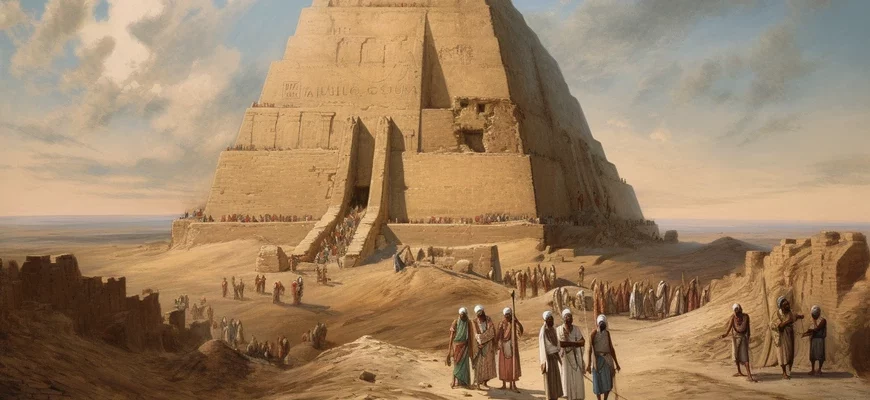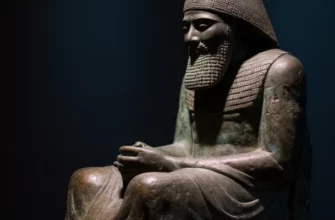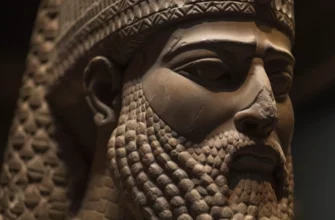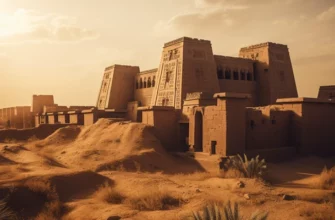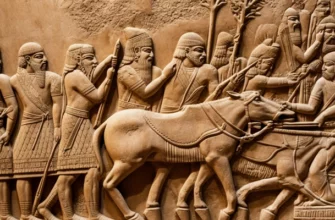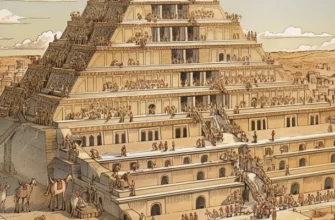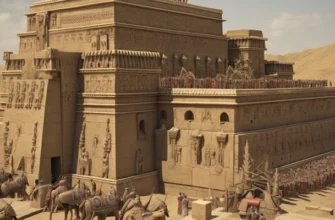The ancient Sumerians were known for their elaborate appearance and cultural customs. They wore intricate clothing with adornments and elaborate hairstyles with patterns. The Sumerians’ lives were connected to crafts and trade, as well as religion and mythology. Their customs, such as family life and funeral rites, influenced their appearance. Knowledge of this ancient civilization helps us understand the cultural and historical connections of our world.
The appearance of the Sumerians
The appearance of the Sumerians reflected their customs and social status. They wore elaborate clothing, including tall hats, leather jackets and trousers, as well as jewelry made of precious stones and metal. Sumerian hairstyles were very complex, with patterns and braids. They often differed depending on a person’s status, and women typically had complex hairstyles with lots of jewelry. The appearance of the Sumerians reflected their high level of development and cultural traditions.
Clothing
Sumerian clothing consisted of several layers, including wool and linen fabrics, which provided comfort in the heat. They also wore leather jackets and pants to protect themselves from the cold. Women’s clothing consisted of woolen sarongs, which were usually worn with a wide belt. The clothing of the Sumerians featured patterns and designs that differed depending on the social status of the person. Jewelry was also popular, including necklaces, bracelets, and earrings made of various metals and precious stones. Overall, Sumerian clothing was very elaborate and luxurious, reflecting their social status and cultural traditions.
Hairstyles and patterns
Sumerian hairstyles and patterns were very elaborate and luxurious. Men wore tall hairstyles with patterns and curved edges that served to protect their faces from the sun. Women’s hairstyles were even more complex and were decorated with beads and precious stones. In addition, patterns and engravings were used on clothing and jewelry, which made it possible to distinguish people’s social status. The Sumerians also used cosmetics such as eye shadow and lipstick to add brightness and expressiveness to their appearance. In general, the hairstyles and patterns of the Sumerians reflected their high cultural diversity and aesthetic taste.
Life of the Sumerians
The Sumerians were one of the most advanced peoples of their time, living in the Euphrates River valley in what is now Iraq around 4000-2000 BC. They invented a writing system and developed art, architecture, and agriculture. Sumerian society was organized on the basis of city-states, each of which had its own center of power and system of government. People were engaged in trade, crafts, and agriculture. The life of the Sumerians was connected with religion; they believed in multifaceted gods who controlled various aspects of life. The Sumerians were also famous for their magnificent temples and pyramids, which became symbols of their culture and faith. All this makes the Sumerians one of the most interesting and influential peoples of the Ancient East.
Religion and Mythology
Religion and mythology were an integral part of Sumerian life. They believed in a pantheon of gods and goddesses, each of whom had their own purpose and power over certain aspects of nature and human life. Sumerian myths describe the creation of the world, the struggle of gods and humans with demons, and events related to the life and death of heroes.
One of the most famous Sumerian myths is the Epic of Gilgamesh, which describes the life and deeds of the legendary leader Gilgamesh. The Sumerians believed in the afterlife and distinguished between two components of the soul: the shadu and the etu. Shadu is the soul of the deceased that remains on earth, and etu is the soul that passes into the underworld after death.
Sumerian mythology also features numerous gods and goddesses, such as Enki, the god of wisdom and water, Inanna, the goddess of love and war, and Marduk, the god of the sky and earth. Religious rituals and cult buildings, such as temples and shrines, were an integral part of Sumerian culture and life.
The daily life of the Sumerians
The daily life of the Sumerians was linked to their economic life. They were a developed civilization engaged in agriculture, crafts, and trade. Their economic life cycle was linked to the changing seasons and rivers.
The Sumerians lived in large cities with developed construction and public infrastructure. They built houses out of clay, as well as mighty fortresses and palaces for rulers and wealthy people.
The Sumerians’ way of life was also linked to their culture and religion. They had their own rituals and religious buildings where religious ceremonies and sacrifices were performed. In addition, the Sumerians had developed arts such as sculpture and painting, as well as literature that conveyed their myths and legends.
Trade and the exchange of goods also played an important role in the daily life of the Sumerians. Their trade extended throughout the Middle East, including Syria, Lebanon, Iran, and Saudi Arabia.
Housing and infrastructure
The housing and infrastructure of the Sumerians were quite advanced for their time. They built their cities on high embankments that protected them from flooding.
Residential buildings were made of clay bricks or clay and were quite large and comfortable. Houses had several rooms, including bedrooms, kitchens, and storage rooms. In addition, they often had their own gardens where they grew fruits and vegetables.
The Sumerians also built public structures such as shrines, palaces, and fortresses. Their cities had convenient infrastructure, such as canals that provided irrigation, roads, and bridges that facilitated trade and communication between cities.
Another important part of the Sumerians’ infrastructure was their water supply systems. They built large water supply systems that allowed them to provide water for drinking, irrigation, and domestic needs.
Overall, the Sumerians’ housing and infrastructure demonstrate the high level of development of their civilization and their care for the comfort and needs of their citizens.
Food
The Sumerians’ diet was quite varied and based on available foods. The main foods were grains such as barley, wheat, and rice, as well as fruits, vegetables, and meat.
The Sumerians grew various types of grains in their fields. They made bread, porridge, and cookies from wheat and barley. Rice was also a popular food in the southern part of Mesopotamia, where rice fields were more common.
Fruits and vegetables such as apples, pears, grapes, cucumbers, and carrots were regularly consumed in their diet. Meat was only a part of the diet for the wealthier classes and included lamb, chicken, pork, and fish.
The Sumerians also consumed dairy products such as cheese and yogurt, as well as honey and sweets. Beverages included water, barley beer, grape wine, and various juices.
Overall, the Sumerian diet was varied and healthy, using many types of foods and ingredients, which allowed them to meet their nutritional needs and enjoy a variety of flavors.
Sumerian customs
The Sumerians had many different customs related to their lives and religion. Here are some of the most well-known Sumerian customs:
Religious rituals and sacrifices: The Sumerians believed in a pantheon of many gods and performed various religious rituals. One of the most important was the ritual of sacrifice, which involved offering animals and other valuable items to the gods.
Family customs: The Sumerians had a fairly developed family structure and adhered to certain family customs. For example, parents took care of their children’s upbringing and passed on their crafts and knowledge to them.
Trade and crafts: The Sumerians were quite advanced in trade and crafts. They produced a variety of items, such as pottery, textiles, and metalwork, which were used both for domestic consumption and for trade with other civilizations.
Religious festivals and holidays: The Sumerians celebrated various religious festivals and holidays that were related to different aspects of their lives, such as agriculture, harvest, and the spring awakening of nature.
Exchange of gifts: The Sumerians had a developed custom of exchanging gifts, which could have both religious and social aspects. For example, the gift of gold jewelry was a sign of wealth and social status.
Overall, the customs of the Sumerians reflected their culture and beliefs, as well as their social and economic practices. They played an important role in shaping society and ensuring its stability and development.
For example, Sumerian customs of trade and craftsmanship helped develop the economy and create craftsmanship, which was one of the main sectors of the economy. Religious festivals and holidays maintained unity and harmony in society and provided a connection between people and the gods.
Sumerian customs also reflected their lifestyle and social status. For example, luxurious jewelry and clothing were indicators of wealth and social status, while simpler clothing and attire were more appropriate for workers and ordinary people.
Overall, Sumerian customs were a complex mix of religious, social, economic, and cultural factors that contributed to the development of this great and influential ancient civilization.
Family life
Sumerian family life was quite traditional for ancient civilizations. The family was the basic unit of society and included parents, children, and relatives. Sumerian society was patriarchal, meaning that the man was the head of the family and had a significant influence on family life.
Marriage was a very important event for the Sumerians. Parents played a key role in choosing a partner for their children, but most marriages were arranged with the consent of both parties. The marriage ceremony was an important part of Sumerian culture and included various religious and social rituals.
Children were very important to the Sumerians, and their upbringing was quite traditional. Parents taught their children various skills, such as crafts and agriculture, and raised them in the spirit of Sumerian religion and culture.
There were different levels of social status in Sumerian society, and this was reflected in family life. Wealthy families were able to hire servants and hired workers, while poor families usually worked on their own fields and in their own workshops.
Overall, family life was an important part of Sumerian culture and society. The family was the foundation of stability and order, and the Sumerians took great care to ensure that it was strong and protected from external dangers.
The influence of customs on appearance
Sumerian customs had a great influence on their appearance. For example, they dressed according to their social status and religious beliefs. The most common type of clothing among the Sumerians was long dresses made of many layers of fabric sewn together. The Sumerians also had a long history of elaborate hairstyles and the use of hair ornaments. These customs reflected their cultural values and religious beliefs and changed over time as Sumerian civilization developed.
The relationship between religion and appearance
The Sumerians were one of the earliest civilized peoples to develop in the territory of modern Iraq around 4000-2000 BC. At that time, religion was very important in their lives, and the appearance of the Sumerians, known from archaeological discoveries, reflects this religious importance.
The Sumerians had a polytheistic religion in which the gods were associated with various aspects of nature and life, such as the sun, moon, water, rivers, etc. The appearance of the Sumerians, particularly their clothing and jewelry, reflected these deities and their religion.
For example, in Sumerian religion, there was a cult of the goddess Inanna, who was the goddess of love, war, and fertility. Her symbol was an eight-pointed star, which the Sumerians wore on their clothing and jewelry. The cult of Nanna, the god of the moon, was also very widespread, and its symbol was the crescent moon, which was also worn on clothing and jewelry.
In addition, the Sumerians believed in life after death and performed religious rituals to ensure the successful passage of the souls of the dead to the other world. This was reflected in their burial practices, where they placed funeral stones with images of gods and symbols to ensure success in the afterlife.
Thus, the connection between religion and the appearance of the Sumerians was quite strong. Their religious system and symbolism were reflected in their clothing, jewelry, and burial rites. This was a very important aspect of their cultural life and coexisted with other aspects such as art, literature, and science.
The appearance of the Sumerians could also vary depending on social status. For example, the upper class may have been more adorned and dressed in silk, gold, and other luxurious materials, while the lower class may have had simpler clothing made of cotton and other inexpensive materials.
In general, the appearance of the Sumerians reflected their culture, religion, and social status. It played an important role in their lives and was one of the aspects that helped them create such a rich and influential civilization.
Conclusion
Based on historical sources, the appearance and lifestyle of the Sumerians can be described as quite complex and diverse. The Sumerians are known for their multi-layered culture and luxurious buildings, such as ziggurats, which reflected their religious and political systems.
At the same time, their appearance reflected their social status, cultural traditions, and religious beliefs. For example, the upper class of the Sumerians could be more adorned and dressed in silk, gold, and other luxurious materials, while the lower class could have simpler clothing made of cotton and other cheap materials.
The daily life of the Sumerians was also quite developed and diverse. Their economy was based on agriculture, crafts, and trade. The Sumerians used an irrigation system that allowed them to increase crop yields and create a developed system for storing and processing food.
Overall, the appearance and lifestyle of the Sumerians were important aspects of their culture and civilization. They reflected their religious, social, and cultural values, which helped create such a rich and influential civilization that is now considered one of the most important in world history.
